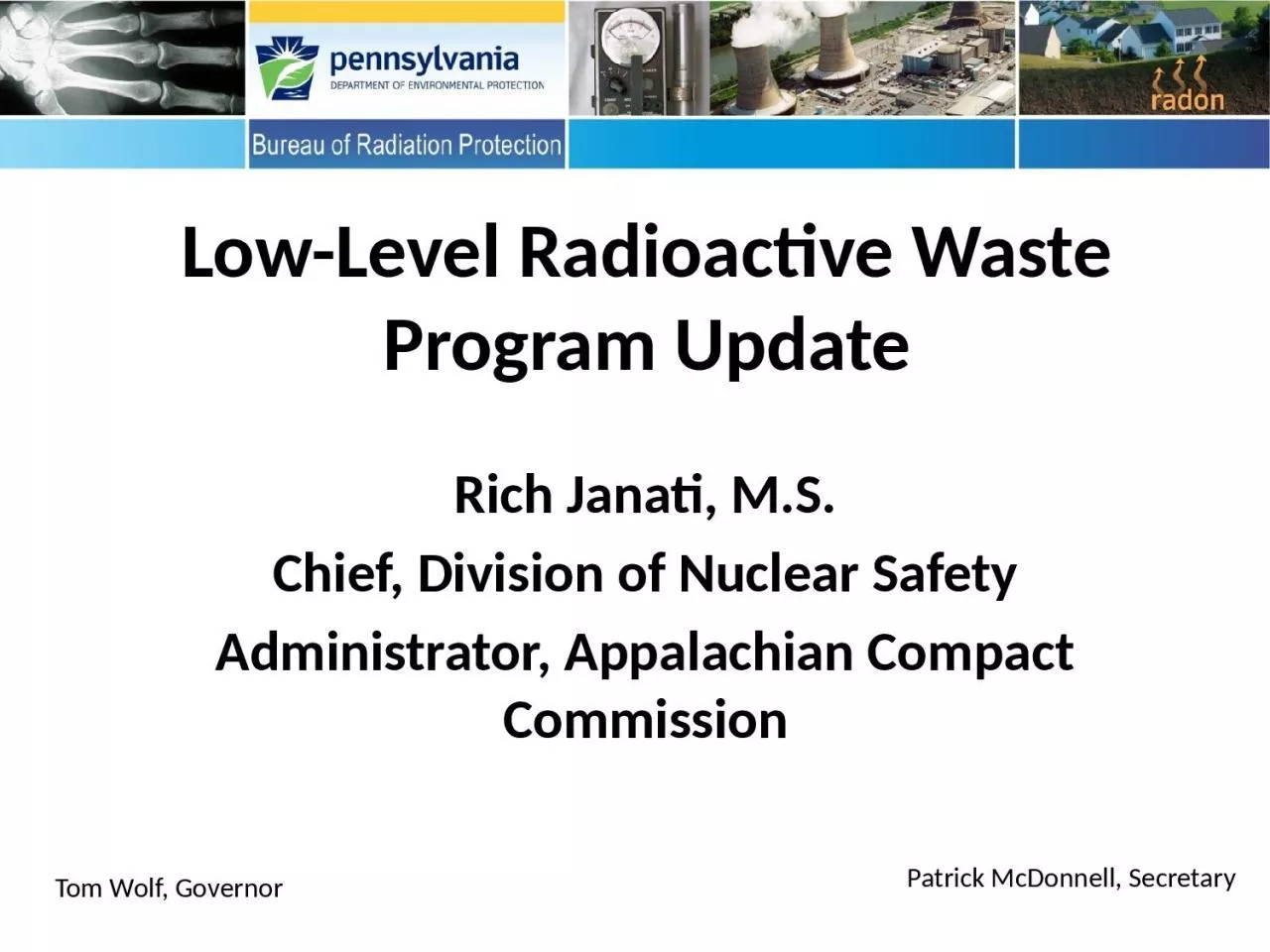

Program Update Rich Janati MS Chief Division of Nuclear Safety Administrator Appalachian Compact Commission Tom Wolf Governor Patrick McDonnell Secretary LLRW is trash or other materials that have been contaminated with radioactivity such as protective clothing paper metal and glass i ID: 1026893
Download Presentation The PPT/PDF document "Low-Level Radioactive Waste" is the property of its rightful owner. Permission is granted to download and print the materials on this web site for personal, non-commercial use only, and to display it on your personal computer provided you do not modify the materials and that you retain all copyright notices contained in the materials. By downloading content from our website, you accept the terms of this agreement.
1. Low-Level Radioactive WasteProgram UpdateRich Janati, M.S.Chief, Division of Nuclear SafetyAdministrator, Appalachian Compact CommissionTom Wolf, GovernorPatrick McDonnell, Secretary
2. LLRW is trash or other materials that have been contaminated with radioactivity such as protective clothing, paper, metal and glass items, ion exchange resins, filter media, incinerator ash, radioactive sealed sources, and some reactor components.Who Generates LLRW?Nuclear power plantsMedical facilitiesIndustrial facilitiesGovernment facilities Research facilitiesLow-Level Radioactive Waste (LLRW)2
3. Low-Level Radioactive Waste (LLRW)NRC regulations in 10 CFR Part 61 has specified a waste classification system for LLRW There are three (3) classes of LLRW: Class A, Class B and Class C The majority of LLRW is Class A waste LLRW Classification3
4. States ResponsibleCompacts EncouragedExclusion of Out-of-Compact WasteFederalLow-LevelRadioactiveWastePolicy ActFederal LLRW Policy Act4
5. Appalachian States LLRW Compact Act of 1985 established the Appalachian CompactCongress consented to the Compact in May 1988Appalachian Compact Commission became operational in June 1990 Commission provides for the regional management and disposal of LLRWCommission consists of 10 members from the party states of PA (4), MD (2), DE (2), WV (2)Appalachian States LLRW Compact Commission 5
6. Statewide Screening 1991 Regional Screening 1993 Local Screening 1994 Volunteer Process 1996-1998 Siting Process Suspended Dec 1998 LLRW Disposal Facility Siting Process Eliminated 78% of Land PA LLRW Disposal Facility Siting Process 6
7. Conceptual Design of the PA LLRW Disposal Facility 7
8. Status of LLRW Compacts8
9. Barnwell Disposal Facility in South Carolina (Regional Facility)Accepts Class A, B and C wastes from the Atlantic Compact (CT, NJ, SC)Closed to generators outside the Atlantic Compact as of July 1, 2008Current projected closure date is 2038Richland Facility in Washington (Regional Facility)Accepts Class A, B and C wastes from the Northwest and Rocky Mountain Compacts (11 states in 2 compacts)Current projected closure date is 2056EnergySolutions Facility in Utah (not a Regional Facility)Accepts Class A waste from the entire nation except the Northwest and Rocky Mountain CompactsProvides for disposal of bulk waste, containerized waste, large components, and mixed wasteTransports large components such as steam generators for disposalCurrent projected closure date is 2050Status of Commercial LLRW Disposal Facilities9
10. WCS Disposal Facility in Texas (Regional Facility)Two facilities: one licenseCompact facility (9 Mft³ and 3.9 MCi)Federal facility for DOE waste (26 Mft³ and 5.6 MCi)Accepts commercial LLRW (Class A, B and C) and federal LLRW and mixed waste Annual limit on radioactivity of out-of-compact waste is 275,000 CiNo annual limit on volume of out-of-compact wasteDisposal of Depleted Uranium (DU) and Greater-Than-Class C (GTCC) waste is being consideredCurrent projected closure date is 2045Status of Commercial LLRW Disposal Facilities10
11. WCS Disposal Facility in Texas 1. Access road to 1,338-acre fenced site (guard house entrance) 2. On-site rail spur and rail-unloading facility 3. Maintenance building 4. Administration buildings with analytical and radiological laboratories 5. Container Storage Building (CSB) 6. Stabilization Building (SB) (West portion) and Mixed Waste Treatment Facility (MWTF) (East portion) 7. Bulk/Bin Storage Units (BSUs)1-3 (bin storage area [BSA-1] is covered)8. RCRA Subtitle C landfill will expand to the East, with closed cells to the West9. 11e (2) Byproduct material landfill 10. Federal Waste Disposal Facility (FWF) for LLW and LLMW will expand to the West 11. Compact Waste Disposal Facility (CWF) for LLW will expand to the East 12. Ten-acre storage area for low-specific-activity (LSA) waste 13. Low-level disposal operations administration building 14. Rail unloading building for emptying gondola cars 11
12. Appalachian Compact Percent LLRW Volume by Disposal Site - 2017 EnergySolutions12
13. Appalachian Compact Percent LLRW Activity by Disposal Site - 2017 EnergySolutions13
14. Coordination and Hosting of Annual MeetingsAnnual LLRW Program ReportNRC Working Group on LLRW StorageLarge-Scale LLRW Blending ProposalLLW Forum Working Group on 10 CFR Part 61LLW Forum Working Group on Disused Radioactive Sealed SourcesInformation Notices re Availability of the Texas Facility and Disposal of Radioactive Sealed SourcesHost State and Appalachian Compact Commission Activities14
15. Questions?Rich Janati, M.S.Chief, Division of Nuclear SafetyAdministrator, Appalachian Compact Comm.Phone: 717.787.2163rjanati@pa.gov